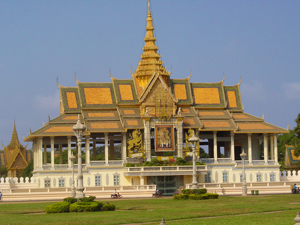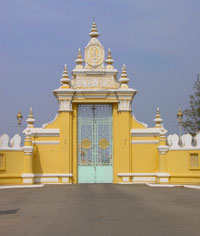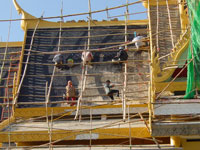The Royal Palace & Silver Pagoda
Preah Reach Veang :
Sothearos Blvd. between Streets 240 & 184
Hours 8:00-11:00 / 2:00-5:00, daily
Admission: 40,000R ($10)/person
Sothearos Blvd. between Streets 240 & 184
Hours 8:00-11:00 / 2:00-5:00, daily
Admission: 40,000R ($10)/person
 The Royal Palace and Silver Pagoda compounds sit together behind the crenellated yellow walls of the royal compound on the riverfront, and are usually seen in a combined visit. Set aside 1-2 hours to see both. Tour guides are available at the gate, and though they charge a fee, are still recommended. As most of the buildings face east, the best light for photos is in the morning hours.
The Royal Palace and Silver Pagoda compounds sit together behind the crenellated yellow walls of the royal compound on the riverfront, and are usually seen in a combined visit. Set aside 1-2 hours to see both. Tour guides are available at the gate, and though they charge a fee, are still recommended. As most of the buildings face east, the best light for photos is in the morning hours.Within the Palace grounds street sounds are silenced and Royal buildings sit like ornate islands rising from the manicured gardens. The Palace serves as the King’s residence, a venue for court ceremony and as a symbol of the Kingdom. It was established at this location when the capital was moved to Phnom Penh in 1866. Khmer and European elements as well as echoes of the palace in Bangkok are present in the design of the buildings.
Attached to the Palace compound, Wat Preah Keo Morokat (the 'Silver Pagoda') is unique amongst pagodas. So named for its silver tiled floor, it is where the King meets with monks, Royal ceremonies are performed and it houses a collection of priceless Buddhist and historical objects including the 'Emerald Buddha.' The temple building, library and galleries were first constructed between 1892 and 1902.
History of the Royal Palace
 The establishment of the Royal Palace at Phnom Penh in 1866 is a comparatively recent event in the history of the Khmer and Cambodia. The seat of Khmer power in the region rested at or near Angkor north of the Great Tonle Sap Lake from 802 AD until the early 15th century. After the Khmer court moved from Angkor in the 15th century, it first settled in Phnom Penh in 1434 (or 1446) and stayed for some decades, but by 1494 had moved on to Basan, and later Lovek and then Oudong. The capital did not return to Phnom Penh until the 19th century and there is no record or remnants of any Royal Palace in Phnom Penh prior to the 19th century. In 1813, King Ang Chan (1796-1834) constructed Banteay Kev (the 'Cristal Citadel') on the site of the current Royal Palace and stayed there very briefly before moving to Oudong. Banteay Kev was burned in 1834 when the retreating Siamese army razed Phnom Penh. It was not until after the implementation of the French Protectorate in Cambodia in 1863 that the capital was moved from Oudong to Phnom Penh, and the current Royal Palace was founded and constructed.
The establishment of the Royal Palace at Phnom Penh in 1866 is a comparatively recent event in the history of the Khmer and Cambodia. The seat of Khmer power in the region rested at or near Angkor north of the Great Tonle Sap Lake from 802 AD until the early 15th century. After the Khmer court moved from Angkor in the 15th century, it first settled in Phnom Penh in 1434 (or 1446) and stayed for some decades, but by 1494 had moved on to Basan, and later Lovek and then Oudong. The capital did not return to Phnom Penh until the 19th century and there is no record or remnants of any Royal Palace in Phnom Penh prior to the 19th century. In 1813, King Ang Chan (1796-1834) constructed Banteay Kev (the 'Cristal Citadel') on the site of the current Royal Palace and stayed there very briefly before moving to Oudong. Banteay Kev was burned in 1834 when the retreating Siamese army razed Phnom Penh. It was not until after the implementation of the French Protectorate in Cambodia in 1863 that the capital was moved from Oudong to Phnom Penh, and the current Royal Palace was founded and constructed.At the time that King Norodom (1860-1904) signed the Treaty of Protection with France in 1863, the capital of Cambodia resided at Oudong, about 45 kilometers northeast of Phnom Penh. Earlier in 1863 a temporary wooden Palace was constructed a bit north of the current Palace site in Phnom Penh. The first Royal Palace to be built at the present location was designed by architect Neak Okhna Tepnimith Mak and constructed by the French Protectorate in 1866. That same year, King Norodom moved the Royal court from Oudong to the new Royal Palace in Phnom Penh and the city became the official capital of Cambodia the following year. Over the next decade several buildings and houses were added, many of which have since been demolished and replaced, including an early Chanchhaya Pavilion and Throne Hall (1870). The Royal court was installed permanently at the new Royal Palace in 1871 and the walls surrounding the grounds were raised in 1873. Many of the buildings of the Royal Palace, particularly of this period, were constructed using traditional Khmer architectural and artistic style but also incorporating significant European features and design as well. One of the most unique surviving structures from this period is the Napoleon Pavilion which was a gift from France in 1876.
King Sisowath (1904-1927) made several major contributions to the current Royal Palace, adding the Phochani Hall in 1907 (inaugurated in 1912), and from 1913-1919 demolishing several old buildings, and replacing and expanding the old Chanchhaya Pavilion and the Throne Hall with the current structures. These buildings employ traditional Khmer artistic style and Angkorian inspired design, particularly in the Throne Hall, though some European elements remain. The next major construction came in the 1930s under King Monivong with the addition of the Royal Chapel, Vihear Suor (1930), and the demolition and replacement of the old Royal residence with the Khemarin Palace (1931), which serves as the Royal residence to this day. The only other significant additions since have been the 1956 addition of the Villa Kantha Bopha to accommodate foreign guests and the 1953 construction of the Damnak Chan originally installed to house the High Council of the Throne.
 From the time of the coup in 1970 when Cambodia became a republic, through the Khmer Rouge regime (Democratic Kampuchea 1975-1979) and the communist regime of the 80s, until 1993 when the Monarchy was restored, the Royal Palace alternately served as a museum and was closed. During the Khmer Rouge regime, former King Sihanouk and his family resided and were ultimately held as prisoners in the Palace. In the mid-90s, many of the Palace buildings were restored and refurbished, some with international assistance.
From the time of the coup in 1970 when Cambodia became a republic, through the Khmer Rouge regime (Democratic Kampuchea 1975-1979) and the communist regime of the 80s, until 1993 when the Monarchy was restored, the Royal Palace alternately served as a museum and was closed. During the Khmer Rouge regime, former King Sihanouk and his family resided and were ultimately held as prisoners in the Palace. In the mid-90s, many of the Palace buildings were restored and refurbished, some with international assistance.Map of the Royal Palace
Royal Palace Building
Throne Hall
The Throne Hall, the Preah Timeang Tevea Vinicchay, is the primary audience hall of the King, used for coronations and diplomatic and other official meetings. This Throne Hall is the second to be built on this site. The first was constructed of wood in 1869-1870 under King Norodom. That Throne Hall was demolished in 1915. The present building was constructed in 1917 and inaugurated by King Sisowath in 1919. The building is 30x60 meters and topped by a 59-meter spire. As with all buildings and structure at the Palace, the Throne Hall faces east and is best photographed in the morning. When visiting note the thrones (Reach Balaing in front and Preah Tineang Bossobok higher at the back) and the beautiful ceiling frescoes of the Reamker.
Chanchhaya Pavilion
The current Pavilion is the second incarnation of the Chanchhaya Pavilion, this one constructed in 1913-14 under King Sisowath to replace the earlier wooden pavilion built under King Norodom. The current pavilion is of the same design as the earlier version. The Chanchhaya Pavilion, also known as the 'Moonlight Pavilion', dominates the facade of the Palace on Sothearos Blvd. The Pavilion serves as a venue for the Royal Dancers, as a tribune for the King to address the crowds and as a place to hold state and Royal banquets. Most recently, the Pavilion was used for a banquet and a tribune for the new King at the 2004 coronation of King Norodom Sihamoni.
Hor Samran Phirun "The pavilion where one sleeps peacefully." Royal rest house and waiting area where the King waits to mount an elephant for Royal processions. Also built to house musical instruments and procession implements. Constructed in 1917. Currently housing a display of gifts from foreign heads of state.
Hor Samrith Phimean
Also know as the ‘Bronze Palace.’ Repository for the Royal regalia and attributes. Constructed in 1917. Currently housing a display of royal regalia and costumes on the ground floor.
Napoleon III Pavilion
At first glance the Napoleon III Pavilion seems almost out-of-place, sitting like a European-style dollhouse amongst the imposing and distinctly Khmer-style buildings that surround it. The Pavilion was in fact the first permanent structure on the site of the Royal Palace. It was originally built for Empress Eugenie of France, wife of Napoleon III, in 1869 for use in the inauguration of the Suez Canal. It is constructed entirely of iron. In 1876 Emperor Napoleon III made a gift of the building to King Norodom of Cambodia. By fortunate happenstance, the royal emblem "N" emblazed on the doors and other parts of the building to honor the name of 'Napoleon' did not need to be altered when the pavilion was transferred to King Norodom. The Pavilion was refurbished in 1991 with financial assistance from the French government. The Pavilion now serves as a small museum housing Royal memorabilia and a photographic exhibition. Best photographed in the morning. (Damnak Chan pictured in the background.)
Phochani Pavilion
An open hall originally constructed as a classical dance theater. The Pavilion is currently used for Royal receptions and meetings. Built in 1912.
Damnak Chan
The Damnak Chan currently houses the administrative offices of the Royal Palace. Original constructed in 1953 for the High Council of the Throne, this building has served several purposes over the years including acting as the Ministry of Culture in the 80s and housing the Supreme National Council of Cambodia from 1991-93. Damnak Chan displays a somewhat uncomfortable mix of Khmer and Western architectural styles, the mix being particularly apparent in this building - sporting a distinctly Khmer-style roof and a Western style in the main body of the building.
Closed to the public.
Khemarin Palace
The Royal residence. Closed to the public.
Villa Kantha Bopha
Western-style villa named after King Sihanouk's late daughter Princess Kantha Bopha, built in 1956 as guest house for foreign guests. Closed to the public.
Royal Palace | Phnom Penh
 Reviewed by Unknown
on
9:51 AM
Rating:
Reviewed by Unknown
on
9:51 AM
Rating:
 Reviewed by Unknown
on
9:51 AM
Rating:
Reviewed by Unknown
on
9:51 AM
Rating:








